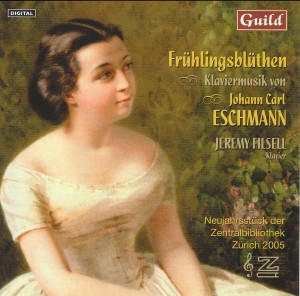ID: GMCD7273 (EAN: 795754727326) |
1 CD |
DDD Released in: 2004
- LABEL:
- Guild GmbH
- Collection:
- Chamber Music
- Subcollection:
- Piano
- Composers:
- ESCHMANN, Johann Carl
-
Interprets:
- FILSELL, Jeremy (piano / organ)
- Other info:
Recorded: St Silas Church, Chalk Farm 27 April 1999 (tracks 1, 4, 8 & 9) and St Paul’s School, Barnes, London (remaining tracks).
The Swiss composer, pianist and pedagogue Johann Karl Eschmann is a little-known figure in 19th-century German music, but he is by no means an insignificant one, for he was one of the few musicians friendly with both Wagner and Brahms, and was admired by both of them. Perhaps he suffered from these dual sympathies, for the Wagnerians thought he was too close to the opposite camp, as it were, and Brahms’s followers felt he embraced too readily the new school of music. Eschmann was neither a disciple of Wagner, nor of Brahms, but recognised the genius in both men. If anything, Eschmann’s art arose from the school of Mendelssohn and Schumann, but his music never slavishly imitated that of those early Romantic masters.
Eschmann was born into a musical family at Wintherthur on April 12th, 1826. His father was kapellmeister to the military choir in Zurich, and a younger sister, Henriette (1829-1896) became a noted music-teacher. Johann exhibited musical proclivities from an early age and, having been born within a musically sympathetic environment, such was his aptitude that his father arranged for him to take lessons initially with Wagner’s friend, Alexander Müller, in Zurich. He progressed rapidly, and was enrolled as a pupil at the relatively new Conservatoire in Leipzig in 1845.
The musical life of Leipzig in those days focussed upon four main centres: the Tomaskirke, where JS Bach had been cantor from 1723 until his death in 1750; the Gewandhaus Orchestra, the oldest-established symphony orchestra in the world, of which Mendelssohn was chief conductor; the Opera House and the new Conservatoire, under the direct patronage of the King of Saxony, Frederick August II, which had opened in April 1843 with Mendelssohn its founder and first director.
Leipzig therefore offered young musicians an excellent environment in which they could develop their potential, and Eschmann was no exception.
At the Conservatoire, Eschmann at first had lessons from Mendelssohn himself, and when Ignaz Moscheles joined the staff in 1846, Eschmann became one of his pupils, studying piano and composition. He returned to Zurich in 1847, and for the next three years taught piano and composition himself there, before moving to Winterthur in 1850, where, during almost ten years in his home city, Eschmann’s reputation grew considerably.
Fleeing Germany in 1849, Wagner sought exile in Zurich, and Eschmann was drawn into Wagner’s circle, along with a group of fellow-composers and artists. Wagner saw Eschmann relatively frequently, and during this period Eschmann produced a distinguished body of work, including a large amount of solo piano music, chamber music and songs. He also appeared as a pianist in concerts promoted by the Allgemeinen Musik-Gesellschaft in Zurich during this period, and, with Wagner, was in the forefront of the musical life of Zurich throughout the 1850s, as pianist, composer, conductor and choral director.
